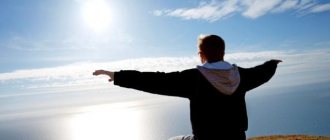Many people of different ages are characterized by a fear of insects. According to leading experts in the field of phobias, this fear was transmitted to modern man from his distant ancestors. Insectophobia (the scientific name for fear) can lead to the development of a severe panic attack at the sight of any insect. Moreover, a person may be frightened not by the living thing itself, but by the image of a terrible monster that is associated with it and quickly emerges in memory. This disorder requires treatment through psychotherapeutic practices under the supervision of a specialist.
Causes of insectophobia
Why are people afraid of insects? There are many reasons that can cause insectophobia, or fear of insects, in a person. The reasons can be divided into two main categories.
Objective factors:
- Lived experience. It often happens that a person develops a disease of fear of insects after being bitten by a bee, mosquito, etc. A similar experience experienced in childhood can lead to psychological trauma, which develops into insectophobia.
- Imitation of others. If there is a person in the family who suffers from insectophobia, the child can learn from him not only to be wary of insects, but also to reinforce the fear, degenerating it into a full-fledged phobia.
- Medical problems. If you have been through a traumatic experience in your personal life due to loss of someone or divorce, the level of stress can create fear in you. Poor mental health, mental retardation and anxiety problems, or poor physical condition due to hyperthyroidism, folate and thiamine deficiency can also contribute to the onset of a phobia. Diseases such as syphilis, meningitis, cirrhosis can give rise to a phobia in you. Schizophrenia is another significant reason for the development of a phobia.
Environment. A person may feel like something is crawling on their body, but this sensation may be due to skin irritation caused by static electricity, pollen deposits and allergens on the pores of the skin or products containing, for example, formaldehyde.
Contrived factors:
- Thoughts of harm. Many patients constantly think about how certain insects can harm them: whether their bites are poisonous, whether they carry infections, and the like. Such thoughts, which may initially be quite rational, gradually become obsessive and contribute to the formation of insectophobia.
- Fantasy. If the previous point was based on objective information and the macrocosm, then in this case the whole problem lies in the patient’s wild imagination. Without any special knowledge about insects, a person imagines them as terrible monsters capable of causing him great harm.
- Literature, cinema, computer games, etc. Images depicting terrible insects, which often do not correspond to reality, an artistically exaggerated description of harm contribute to the formation of insectophobia,
Signs and symptoms
Symptoms that may indicate entomophobia or insectophobia:
- Constant complaints of insect bites are the main symptom of insectophobia, that is, a phobia such as fear of insects.
- Reclusion.
- Reading about insects to see if fear is rational.
- Obesity.
- Frequent visits to doctors due to skin problems.
- When thinking about insects, physical tension appears, expressed in symptoms such as shortness of breath, nausea, and vomiting.
- A panic attack at the sight of an insect is also a sign of insectophobia.
- Isolation from society.
The symptoms are so common that a person often does not realize that they are developing a phobia - the fear of insects. The main symptoms of any phobia are:
- Panic when confronted with the cause of fear or even at the thought of the source of fear.
- The desire not to leave the house in order to avoid confrontation with the source of fear.
- A feeling of powerlessness due to the fact that a person cannot control fear, even knowing that it is irrational.
- The children start crying.
- Development of physical symptoms such as inability to breathe, sweating, and vomiting.
First aid for panic attacks
In a moment of panic, a person thinks that he will suffocate, die, or go crazy. Somatic symptoms include ringing in the ears, dizziness, and nausea. It is better to entrust the treatment of panic attacks to a specialist; in this case, drug treatment is indicated. But it's important to know what you can do if a panic attack takes you by surprise.
First aid for a panic attack:
- focus on any object, this is necessary to switch attention;
- take several deep, long breaths in and out, this is necessary to normalize breathing and heartbeat.
You can use a paper bag. Take one deep breath and after eight seconds exhale slowly into the bag, repeat the procedure for five minutes.
Exercise and communication with loved ones are indicated as additional methods and means of prevention. Try to spend less time alone, especially before an upcoming meeting with the subject of fear.
Tests for diagnosing insectophobia
Currently, there are no proper tests to identify a specific phobia, so doctors turn to the Diagnostic and Statistical Manual of Mental Disorders, published by the American Psychiatric Association, to test various criteria for identifying insectophobia. The guideline also suggests the type of treatment that can be administered to the patient. During therapy sessions, you will be asked various questions, and your response to them will serve to determine the phobia. Your medical and psychological history and heredity will also help doctors in the identification process.
The main criteria that help diagnose insectophobia are:
- A feeling of intense fear and irritation when the patient notices an insect or even sees a picture of it.
- Fear even at the thought of insects.
- Avoiding encounters with any insects or even viewing images of insects.
- Avoidance of all types of social activities that occur outside the home so that the patient can avoid encounters with insects. When an insect approaches a person, he noticeably tenses up.
- Symptoms of the phobia continue for more than 6 months.
It is worth noting that fear of insects is inherent in most people, but in order to determine which fear of insects is a phobia in its pure form, it is still worth contacting a specialist. He is the one who will help you understand and establish an accurate diagnosis.
What does behavioral theory say?
From this point of view, there are two mechanisms that provoke insectophobia. They can be:
- Conditional;
- Simulated.
Fear of insects develops for several reasons:
- The child is disturbed by a feeling of discomfort and fear. In this case, the problem is that there is no connection with the object. An insect suddenly appears in his field of vision. It doesn't matter who the beetle is, the mosquito. During the flight, it makes sounds, the child turns the unpleasant situation onto himself. A formula instantly forms in the subconscious: insect = pain (or fear or feeling of discomfort). This is a conditioned way of developing anxiety in front of insects.
- The modeled path is associated with the behavior of parents or other people who are authorities for the child. If the child’s mother or father is terrified of the spider, then the baby will also perceive it as a source of threat. However, it is not only the reaction of parents that can trigger this mechanism. An impressionable child is able to obtain information that is “useful” for him after watching a science fiction film where insects play the role of the main villain.
That is why you should very carefully monitor your behavior and what films your children watch. The baby himself will not be able to distinguish reality from fiction.
How does insectophobia manifest?
In order to understand whether we are talking about a pathological condition, or a banal fear of insects, you need to observe a child or an adult. Characteristic manifestations will be:
- Manifestation of panic that is impossible to cope with. A person is trying to escape or hide somewhere. In this case, a state of intense anxiety is manifested by sudden pallor or redness. A characteristic sign of a panic state is dilated pupils and a state of very strong psychomotor agitation.
- Often, out of fear that an insect may cause harm, a person begins to use insecticides or other household chemicals as protection. However, there is no obvious need for this. He tries to wear protective clothing or a mask, or tries to avoid going into nature, or simply sits at home, afraid that insects may attack him.
- You can also note a characteristic state when a person expects danger, he listens intently and observes the surrounding space in fear that there is an object of fear nearby.
Independent actions
If the case is not advanced and your phobia is at the initial stage of development, it is important to understand what exactly is bothering you - what insects and possible causes of fear. By answering these questions yourself, you can choose how to deal with your fear of insects.
- If you are afraid of the unknown or there is no information about this or that representative of the macrocosm, you should read an encyclopedia about insects, study pictures, detailed descriptions. You can also watch documentaries, just make sure (ask someone to watch the film in advance) that it does not contain scenes that frighten you, for example, contact of insects with people, insect attacks on humans, etc. This method is suitable for both children, as well as for adults.
- If the cause of your fear is a feature film, you should watch it again, not forgetting that everything that happens on the screen is fiction. When using this method with children to help them get rid of their fear of insects, think carefully about the approach, otherwise the situation may only get worse.
- If insects are simply unpleasant to you, for no apparent reason, consider buying photo wallpaper depicting representatives of the macrocosm. Souvenirs and accessories will also help - having gotten used to seeing only decorations in an insect, a person will gradually forget about fear.
What methods of correcting the condition exist?
The most effective ways to correct a patient’s condition with insectophobia is considered to be psychological assistance , supplemented by drug therapy - antidepressants, antipsychotics, sedatives.
In the most severe and advanced cases, hypnotherapy can be used , during which the fear of arthropods decreases and the patient returns to their real perception. An integrated approach helps solve the problem of insectophobia and relieve a person of panic fear of insects.
An effective method of correction is group psychological sessions with people suffering from the same phobic disorder . It is also useful to visit various insect exhibitions, where they can be examined in detail through glass.
To reduce your fear of insects, you can read books with their images or visit specialized Internet sites. This will give you the opportunity to get used to their appearance and make sure that there is no danger to people.
Treatment of insectophobia
If the methods listed above did not help you cope with the problem, be sure to seek help from a professional.
Entomophobia, or insectophobia - as the fear of insects is called - is often mistakenly considered a mental illness. Because this phobia is not well documented in the list of similar disorders, doctors are often unable to identify it. The patient remains without proper treatment for a long time. Therefore, the diagnosis of phobia is very important and multidisciplinary approaches should be taken.
Some therapeutic treatments for insect phobia along with prescribed medications allow the patient to remain calm and in control. Often during psychotherapy, an entomologist is brought in for consultation to help the patient understand that his fear is irrational.
Fear of infection
In many cases of entomophobia, the patient is afraid of becoming infested with insects. Many insects, such as cockroaches and flies, carry diseases. However, people with infection phobias take reasonable caution and precision to extremes. In addition, there is disgust, a reaction that often causes symptoms of anxiety. A variety of studies conducted in the 2000s have shown that we react more strongly to creatures we find disgusting than to animals that may be more dangerous in nature. This may be an evolutionary response to our ancestors' misunderstanding of disease prevention.
Desensitization, or exposure therapy, to treat insectophobia
Desensitization or exposure therapy to treat insectophobia helps overcome fear by exposing the patient to the object of fear. For example, the first images of insects are shown so that the patient can influence and reduce his level of anxiety. Slowly, as the patient begins to understand that not all insects are harmful, he is taken out into the garden where he may come into contact with flies or bedbugs.
Medicines for the treatment of insectophobia
Although medications cannot reduce insectophobia, they can help you control the physical symptoms that arise from the phobia.
- Antidepressants are called serotonin reuptake inhibitors, which control your mood by working as neurotransmitters in your brain. Antidepressants are prescribed according to your condition.
- Sedatives for insectophobia are those medications that are also known as benzodiazepines and help calm your nerves and make you less anxious. But at the same time, you should be careful while taking these pills as you may develop addiction and there may also be adverse effects if you take alcohol.
- Beta blocker medications block the stimulating sensations you experience due to entomophobia. The medicine also reduces heart rate caused by anxiety. A small amount may improve your condition for a while.
Risk factors
There are several factors that may put you at risk of developing a phobia:
- If you notice that anyone close to you, such as father, mother, brother, etc., suffers from insectophobia, you risk developing this fear in yourself as well.
- If you have experienced a traumatic incident in the past, you may develop fear of the source.
- Specific phobias develop even at the age of 10, so you become unable to interact with people.
Description of the violation
Not all people know what the fear of insects is called. The general term for this phobia is insectophobia. There are several more species identified. For example, if a person is only afraid of bees, then this should be called apiphobia; fear of ants is called myrmecophobia.
Disgust and the desire to avoid insects are inherent in every person. This was necessary for the survival of the species, since some individuals were poisonous or could carry various diseases, such as malaria or parasites.
Another name for insectophobia is entomophobia. Pathological fear can occur at any age. In severe cases, a person stops leading his usual way of life, he looks everywhere for the object of his fear.
For example, the fear of flies is called dipterophobia. With it, a person will be terrified of encountering black flying insects. They can be found in stores or in garbage dumps.
Complications
A phobia that bothers someone and causes serious problems in their life may not seem like a concern to others. A patient suffering from insectophobia may have many complications, such as:
- Avoiding any social interaction because of the thought that people might laugh at him. This behavior can lead to reclusiveness and loneliness.
- The complication of insectophobia leads to clinical depression or develops anxiety disorders.
- Substance abuse to cope with stress caused by fear.
Travel paths
Due to their small size and ability to reproduce quickly, insects can get into the most inaccessible corners of your home or the surrounding area. Some people may become numb and disgusted at the mere thought of someone crawling on their body. The speed at which arthropods move is also amazing. And if we are talking about home invasion, then disgust and fear can be caused by the loss of environmental control. In other words, if someone is encroaching on your personal space and even crawling through your things, you will not be able to feel safe.
Turkey and cheesecake. Signature holiday recipes from Natalia Podolskaya
On January 1 of this year, new rules for using beaches appeared.
The taste of vegetables and fruits depends on a person’s mood: study
Also, you cannot guarantee that these small and nimble creatures will not bring any infection into your home. This is why insects evoke feelings of disgust and disgust. This instinctive reaction varies from culture to culture and has a lot to do with man's natural tendency to reject anything that might make him sick.











